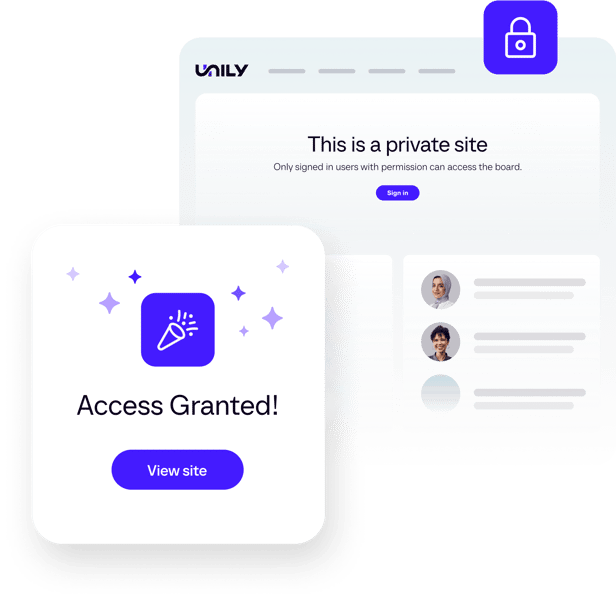Extranet Software
Your customers demand faster reactions and actions. This means not only interacting faster with the consumer themselves but with your employees, supply-chain and partners. Technological innovations have paved the way for more efficient collaboration pathways than ever before. This can only happen effectively and with the proper controls in place in a digital space.
In decades past, stakeholders who wished to share materials with external partners faced limited and inefficient options. With the proliferation of modern extranets, the options for third-party collaborators are endless. Explore what extranets are, how they can be implemented within your workplace, and tips to maximize collaboration capabilities with external users.

Most popular Extranet Software pages
Extranet
Discover the resources you need for the ultimate extranet software for today’s reimagined workforce.
What can an Extranet achieve for you?
Probably more than you think. Extranets open up realms of possibilities that you and your team may not have thought about. Creating a digital workspace that reaches outside of an organization to improve collaboration and innovation requires changing an organization's thinking.
Extranets can be a solution for numerous situations, such as;
- Supplier & Vendor management
- Partner portals
- Franchise networks
- Alumni communities
- Training & Education
- Innovation communities
- Digital services platforms
- Customer support
With our experience in delivering enterprise platforms, our customer success managers work on an ongoing basis with clients as we know your needs will evolve over time. Unily’s powerful extranet allows you to communicate across the whole platform audience in an easy yet, very powerful way. Tailor messaging with AI and dynamic audience groupings. Create communities across different regions, functions and backgrounds. Allow users to control what they see and how they see it with in-platform personalization. Reach all platform users in any location on any device with our mobile app and AI-powered translation.
The benefits of an extranet
Extranets can come with a host of benefits, regardless of the type of network your organization utilizes. Ultimately, an extranet breaks down the barriers between a business and external stakeholders. The benefits of improving such communication and collaboration can have a great positive impact on a company, driving innovation, efficiencies and ultimately profits. In short, an extranet offers extra benefits.
Creating a network that breaks out of the confines of a business at first might seem counterintuitive – the whole point of an intranet is that it enables staff to use tools specific to them and their business. However, providing outsiders with limited access to certain elements of an intranet, creating an extranet, can create significant advantages. Some of the most noteworthy improvements stakeholders can expect to witness after implementing an extranet are as follows:
Maximize knowledge sharing
Take full advantage of the ideas and expertise of everyone involved. External partners are given a powerful platform to collaborate, share best practices, weigh in on pressing topics and provide valuable feedback to troubleshoot for future interactions. An extranet encourages everyone to weigh in and optimizes the information flow throughout all parties.
Quicker time to market
Sharing knowledge like designs and specifications immediately with suppliers can improve the speed at which products can be created. An extranet can give employees and partners a central source of truth to keep projects on track, and create a digital space for collaboration.
Immediate and accurate information
Important data can be updated and distributed to relevant parties at the click of a button, reducing any confusion or costly errors caused by delays, for instance updating prices or inventory information. The Unily platform provides an award-winning CMS with advanced document revision control, powerful internal search, push notifications, and so much more.
Keep information confidential and secure
In many cross-organization collaborations, stakeholders must ensure that third-party users have the information they need to participate without divulging confidential material. Extranets can make it easy for leaders to manage who can see what, through customizable permissions options and various authentication modes. External platforms are thought of as one of the safest ways to share documents and data thanks to their extensive array of privacy and permissions controls.
Receive real-time updates seamlessly
Extranets help organizations deliver the kind of minute-by-minute notifications consumers have grown to expect, without taxing employee productivity levels. Clients and partners can be granted access to an external network that enables them to access real-time updates whenever they want or need them.
Process automation
Extranets connected to external suppliers can be set up to monitor business activities and automatically place orders when certain parameters are met, such as supplies are running low or a specific event is coming up. With Unily's AI-powered intranet you can automate more than ever, freeing up time for creativity and collaboration.
Reduce silos
One of the most challenging components of cross-organization collaboration is the proliferation of silos that can prolong tasks and weigh down interactions between stakeholders. A streamlined extranet can help cut down on the chatter and provide every collaborator with the tools, updates, and documents they are searching in an efficient manner. Modern extranets have high-functioning search capabilities that can further drive effective knowledge management and reduce the lag time that is all too common when working with multiple parties.
Recognize key players
Extranets provide a sophisticated digital solution for stakeholders who are eager to ensure that everyone stays on task and feels recognized for their work. In project management situations, external networks can be utilized to ensure communication and understanding flows freely between all parties. Additionally, these platforms can highlight who has gone above and beyond with rewards and recognition functionality.
WACKER: enhancing collaboration with a user-centric intranet
From scientists to engineers, WACKER’s workforce is comprised of experts that have set the enterprise apart as a pioneer of modern chemistry for more than 100 years. To pave the way for the next century of innovative work, WACKER sought to launch a user-led solution that would reimagine collaboration across the enterprise, including its extended network of partners.
Read the case studyTips for creating an optimized extranet experience
Organizations that choose to design an extranet in order to facilitate third-party collaboration that is efficient and effective are already a significant step ahead of the game. In order to create the best extranet possible for your organization, be sure to consider the following tips.
Prioritize your users
In years past, virtually all extranet solutions were designed with Sharepoint as their foundation. While Sharepoint offered a viable option, the newest external platforms have tools and functionalities that transcend the bounds of older models. Innovative extranets prioritize the experience of unique users, while traditional platforms simply offer a standardized means to transfer documents and data. An intuitive extranet with tools and capabilities that align with specific collaborations will empower all parties to remain engaged and productive throughout your partnership. When designing an extranet, stakeholders need to prioritize users during the design and implementation process for maximum success.
Pinpoint the central tasks and functionalities
As described above, there are a variety of different types of extranets and each fulfills specific functions. Reflect on the main goals and tasks your extranet will need to support. An external platform that is designed to update inventory will likely look very different from an extranet that was created to facilitate task management. When building an external platform, leaders need to consider what kind of collaborations are most integral to their organization and seek out an extranet that aligns with these demands.
Include a mobile option
In order to maximize the usability of your extranet, ensuring that it is mobile responsive is highly advantageous. A mobile intranet can be particularly valuable when collaborating with front-line staffers outside of your organization, such as contractors, deliverymen, and couriers. These non-connected workers are unlikely to be sitting in front of a computer all day, so mobile access to your extranet is particularly crucial.
Ensure your platform is secure
Security is a growing concern for virtually all organizations as the threat of data leaks looms large. Extranets can be an efficient option to securely share data and documents with customizable security features and permissions controls. Personalized sharing options are particularly integral for extranet design as some parties may need access to more information than other collaborators. External networks enable stakeholders to pick and choose who can see what and update it whenever necessary.
Consider how your extranet and intranet will come together
Many stakeholders may choose to view their extranet as an extension of their organization’s internal network. It is likely that some of the features and functionalities within your existing digital workplace will likely be valuable to your outside platform. Some examples of transferrable tools might include social networking functions and integrations with business applications like Salesforce or HubSpot. When designing an efficient and effective extranet, it can be beneficial to pinpoint functionalities within your intranet that are likely to be useful to third-party collaborators as well.
Start building the best extranet software for you
The first step to digital transformation starts with finding the best software for your organization. For those eager to get started, reach out to our experts to begin your extranet journey.







